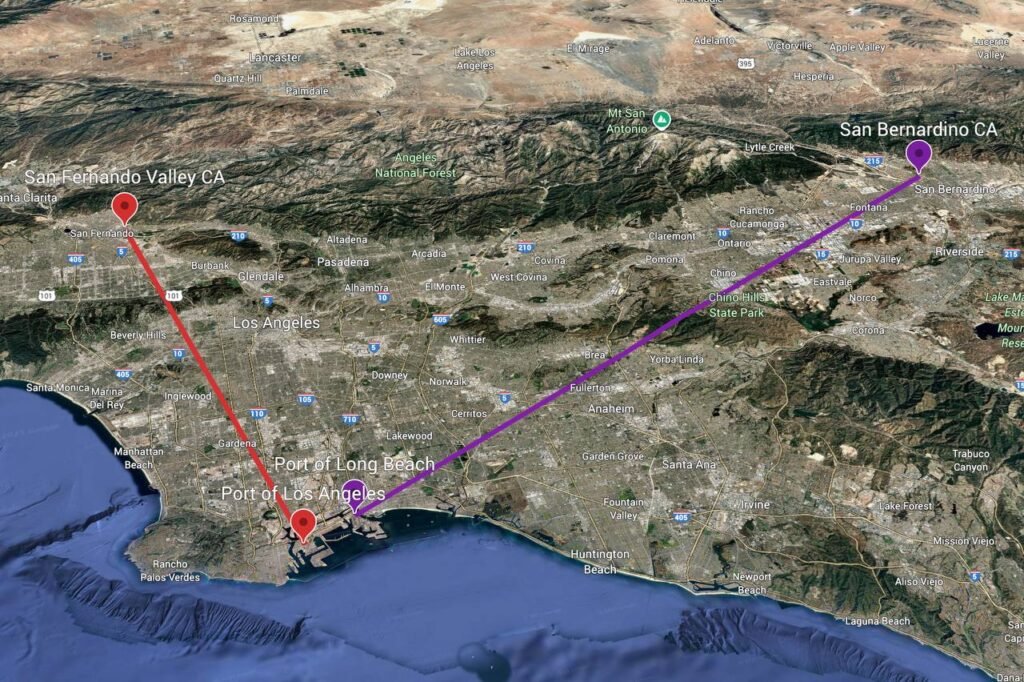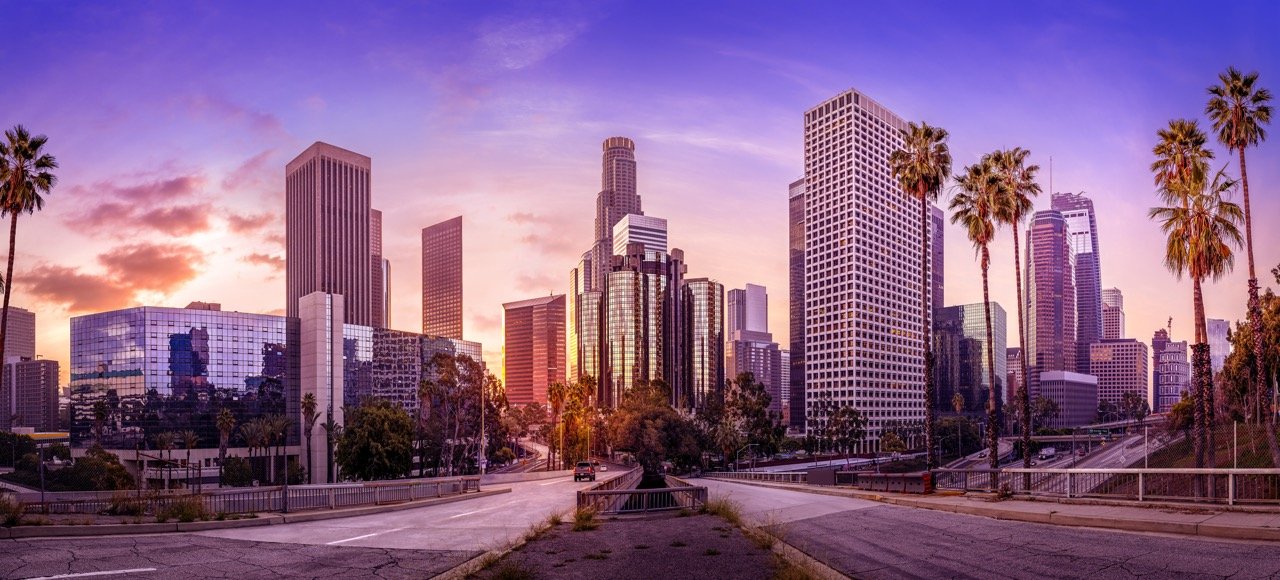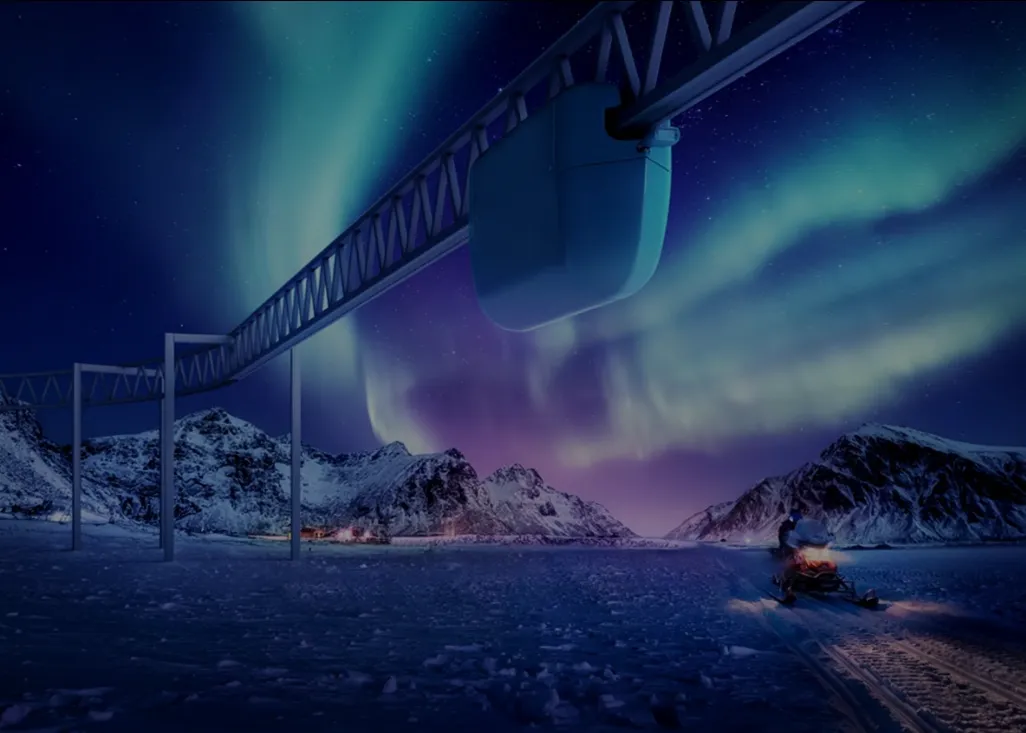Executive Summary
Los Angeles County is on the brink of significant change: projections show a 15% population increase by 2050, adding 1.5 million residents to reach about 11.3 million.[37] This growth risks amplifying the inefficiencies of an outdated trucking sector, crumbling infrastructure, and archaic systems, leading to massive economic and social strains—including billions in costs, heightened emissions, and a drag on California’s Gross State Product (GSP), currently at $4.103 trillion. Without urgent innovation, residents face escalating household expenses, health risks from pollution, and gridlocked daily lives.
The American Dream Rail system offers a transformative solution: a high-speed, scalable rail network linking the Port of Los Angeles—handling around 178 million metric tons annually (approximately 196 million short tons)—to a new distribution center in San Bernardino, 76 miles away.[13] Operational at full capacity by 2035 and funded by the $5.5 trillion legacy project, it targets 50% of the port’s specified 81 million short tons of container freight, delivering benefits like 50% cost and time reductions, 75% lower emissions, and congestion relief. Revenue includes an Air-Use tax of 16% on $6.00 per 100-ton mile, injecting millions into city coffers.
The “before” outlook is grim with unchecked growth; the “after” envisions a vibrant, efficient LA boosting GSP, equity, and sustainability. Cost-savings differentials reveal over $100 billion in net gains, underscoring the imperative: embrace Dream Rail now for a thriving future that uplifts communities and powers American industry.

Introduction
Picture a Los Angeles where seamless mobility replaces endless traffic snarls, freight flows effortlessly, and growth fuels opportunity rather than overload. Yet, with a projected 15% population spike by 2050 adding 1.5 million souls, the city’s strained transportation—inefficient trucks, aging roads, and outdated logistics—threatens chaos. This case study urgently dissects the pre- and post-growth impacts on citizen and goods movement, championing the American Dream Rail as a scalable savior. Drawing on fresh data, we highlight escalating needs, costs, and consequences, then pivot to optimistic outcomes with Dream Rail’s integration. The stakes are high, but the potential is boundless—let’s forge a connected, prosperous LA.
Background Information
As America’s trade gateway, the Port of Los Angeles processes about 9.3 million TEUs annually, equating to 178 million metric tons or roughly 196 million short tons of cargo. Yet, reliance on inefficient trucking amid obsolete infrastructure exacerbates delays and emissions.
LA County’s current 9.8 million residents are set for a 15% rise to 11.3 million by 2050, driven by economic allure and demographics. This surge heightens freight and commuter demands, straining systems already facing gentrification-induced transit declines. California’s GSP stands at $4.103 trillion, but projections warn of slowdowns without infrastructure leaps.
Historical growth has spurred commerce but also inequities; now, with climate threats looming, bold action is essential to sustain vitality.
Problem or Challenge
By 2050, LA’s population boom intensifies transportation woes, demanding immediate reckoning. The “before” scenario reveals daunting impacts:
○ New Essential Needs for the City and People:
Vast transit expansions, including rail, buses, and active transport to accommodate 1.5 million more residents.
Advanced port and freight logistics to manage rising trade volumes amid e-commerce booms.
Resilient infrastructure upgrades for climate extremes, plus enhanced safety and emergency networks.
Aggressive emission-reduction programs to safeguard health against pollution spikes.
○ Breakdown of Projected Costs to the City:
Statewide transportation shortfalls exceed $215 billion through 2035 alone; LA’s portion, including Measure M’s $120 billion over 40 years, could surpass $50 billion by 2050 for repairs and expansions.
Freight and port enhancements: Billions more to counter trucking delays, potentially $10-15 billion in targeted investments.
Cumulative city expenditure: $80-100 billion by 2050, sourced from taxes, bonds, and grants.
○ Cost to Individual Households
- Tax hikes via measures like Measure M’s 0.5% sales tax, estimated at $25-287 per household annually based on spending, but realistically $200-500 considering full burdens.
- Hidden costs: Congestion fuels $1,000-2,000 yearly in time, fuel, and maintenance; pollution-related health bills add $200-500.
○ Projected Shortfalls:
Funding deficits: Even with investments, $20-30 billion gaps loom from inflation and priorities like housing.
Operational limits: Trucking bottlenecks could strand 20-30% of freight, worsened by labor shortages.
○ Potential Consequences for Failing to Meet Shortfalls:
Crippling congestion: Doubled commute times erode productivity and access.
Economic erosion: Supply chain lags cost jobs and competitiveness.
Social divides: Vulnerable groups suffer disproportionate pollution and isolation.
○ Effect on Gross State Product (GSP):
Inefficiencies may trim 0.5-1% from annual GSP growth, risking $50-100 billion losses by 2050 as bottlenecks hinder trade.
○ Cost of Increased Emissions:
Climate toll: Annual costs around $780 million for heat, floods, and fires, cumulatively $15-20 billion by 2050; emissions rise 10-20%, fueling health crises.
The crisis demands action—growth must not suffocate progress.
Myron Manuirirangi
Solution or Approach
The American Dream Rail system shines as the scalable antidote: a passenger-freight rail from the Port of LA to San Bernardino’s new distribution center, relocating processing for efficiency.
Benefits, as user-outlined, include bypassing congestion, cutting truck traffic, zero accidents, 50% cost/time savings, and 75% emission drops—without disrupting security or urban rhythm.
Targeting 50% of 81 million short tons (40.5 million annually), it manages 110,959 short tons daily via 924 vehicles at 65 mph, spaced 0.152 miles (9.2-second intervals). Ton-miles: 40,500,000 × 76 = 3,078 million. Revenue at $6.00/100 ton-miles: $184.68 million yearly. Air-Use tax (16%): $29.55 million to the city.
Before vs. After differentials:
- Before (No Dream Rail): $80-100B city costs, $1,200-3,000 household loads, $20-30B shortfalls, $50-100B GSP hit, $15-20B emissions.
- After (With Dream Rail): 50% cost cuts save $40-50B, households trim $600-1,500, shortfalls drop to $5-10B (tax-offset), GSP gains $50-100B, emissions slash 75% ($11-15B saved). Net savings: $100B+ , flipping urgency to opportunity.
Implementation
Funded by the $5.5 trillion project, construction costs: $70M/mile × 76 = $5.32B; vehicles $150K × 924 = $138.6M; total $5.46B. Timeline: Build from 2026, full ops 2035, blending with port flows. Monitor via yearly metrics on capture, reductions, and revenues for nationwide scaling.
This blueprint promises an empowered LA—efficient, inclusive, and forward-bound.
#SignForAmericaLet’s make America unstoppable.
Sign the petition today for your sake, more so than President Trump’s.
Phone Numbers
Work: +1 (305) 000-0000
Support: +1 (888) 000-0000
Our Location
Work: +1 (305) 000-0000
Support: +1 (888) 000-0000
American Patriots, Inc., c/- dba: American Dream Rail Legacy Project
Miami FL, 33127
contact@AmericanDreamRail.com



